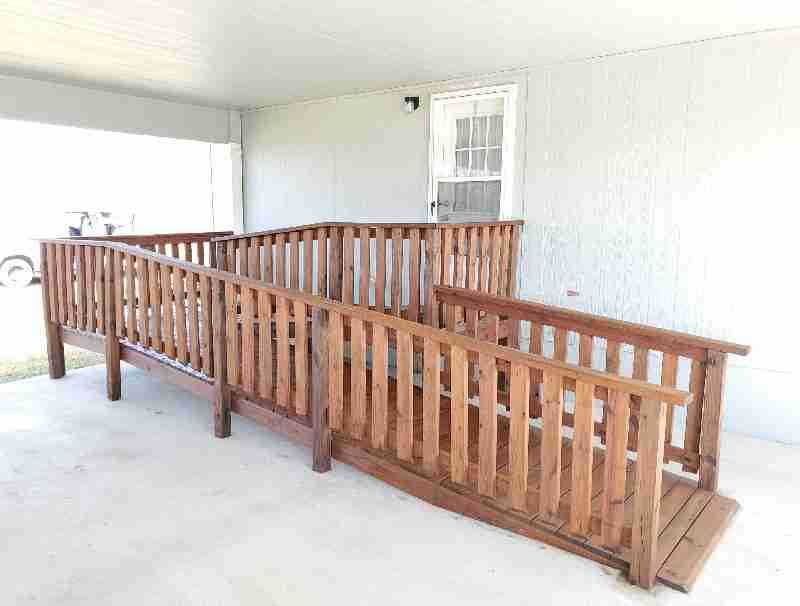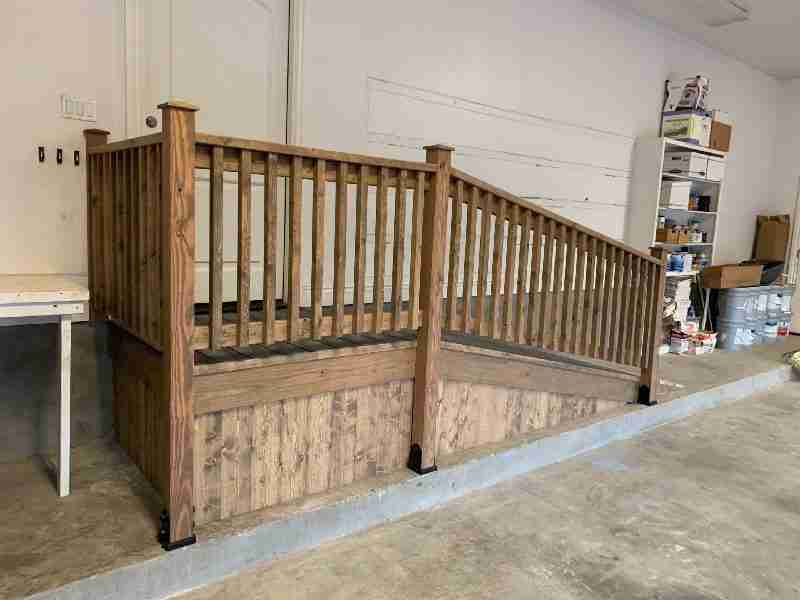As a business or property owner, it’s important to ensure that your property is accessible to everyone, including individuals with disabilities. Installing a wheelchair ramp can make a significant difference in improving accessibility, but it’s crucial to ensure that the ramp is constructed according to the Americans with Disabilities Act (ADA) regulations.
At Butler Contracting, we understand the importance of providing accessibility solutions, and that’s why we specialize in building decks and ramps in Bastrop and the surrounding areas. In this article, we’ll cover the ADA ramp codes in Bastrop, Texas, and provide guidance on how to construct a wheelchair ramp that meets the regulations.

What are ADA Ramp Codes?
ADA ramp codes are regulations established by the Americans with Disabilities Act to ensure that public facilities, commercial buildings, and other structures are accessible to individuals with disabilities. The codes provide specifications on the design, construction, and installation of wheelchair ramps to ensure safety and accessibility.
Requirements for Wheelchair Ramps in Texas
In Texas, the ADA ramp codes are enforced by the Texas Accessibility Standards (TAS). Here are some of the essential requirements for wheelchair ramps in Texas:
Slope
The maximum slope for an ADA ramp is 1:12. For every inch of vertical rise, there must be at least 12 inches of ramp run. For example, if your wheelchair ramp needs to rise six inches, the ramp run should be at least 72 inches long.
Width
The minimum clear width of a wheelchair ramp is 36 inches. If there are any turns in the ramp, a minimum clear width of 42 inches is required.
Rise
The maximum rise for any ramp run is 30 inches. If a ramp must rise more than 30 inches, it should be divided into sections with a landing in between. The landing should be at least 60 inches long and as wide as the ramp.
Handrails
ADA requires that handrails be installed on both sides of the ramp. The height of the handrails should be between 34 and 38 inches above the ramp surface.
Landings
Landings are required at the top and bottom of every ramp, as well as at any point where the ramp changes direction. Landings should be at least 60 inches long and as wide as the ramp. They should also have a slope of no more than 1:48.
Surface
The surface of the ramp must be slip-resistant, firm, stable, and continuous. Any changes in level must be flush.
Converting Stairs to Ramps
It’s possible to convert stairs to ramps, but it’s essential to ensure that the ramp meets the ADA regulations. Converting stairs to ramps will require a significant amount of planning and construction, but it’s worth it to provide accessibility to everyone.

Standard Ramp for Disabled
There is no standard ramp for disabled individuals. ADA ramp codes provide specific requirements that must be met to ensure the ramp is safe and accessible for people with disabilities.
Step Ramps vs. Threshold Ramps
Step ramps and threshold ramps are two types of ramps that are commonly used to provide accessibility to homes and buildings. While they serve similar purposes, there are some differences between the two.
Step Ramps
Step ramps are designed to provide access over a set of steps or a raised entryway. They are typically constructed from wood or concrete and can be customized to fit the specific dimensions of the space.
Step ramps must meet the same slope and rise requirements as standard ramps, and they also require landings at the top and bottom of the ramp. Handrails are also required if the ramp is wider than 36 inches.
Threshold Ramps
Threshold ramps are designed to provide a smooth transition from one level to another, such as from a doorway to a patio or deck. They are typically made from lightweight materials like aluminum or rubber and are available in a range of heights to fit different thresholds.
Threshold ramps do not require the same slope and rise requirements as standard ramps, but they must be no higher than 1/2 inch high to be considered accessible. Handrails are not required for threshold ramps.
It is important to choose the right type of ramp for your needs, depending on the specific location and purpose of the ramp. At Butler Contracting, we can help you determine which type of ramp is best suited for your situation and ensure that it meets all ADA ramp codes in Bastrop, Texas.
Does OSHA Regulate Wheelchair Ramps?
The Occupational Safety and Health Administration (OSHA) does not have specific regulations for wheelchair ramps. However, OSHA does require employers to provide reasonable accommodations for employees with disabilities, which may include the installation of a wheelchair ramp.
While OSHA does not have specific requirements for wheelchair ramps, it is still important to ensure that ramps are safe and meet ADA ramp codes in Bastrop, Texas. This is important not only for the safety of individuals with disabilities but also for the safety of others who may use the ramp.
At Butler Contracting, we have extensive experience building and installing ADA-compliant ramps that meet both ADA and OSHA requirements. If you need a wheelchair ramp for your business or organization, we can help ensure that it is built to the highest standards of safety and accessibility.
How Do I Make My Stairs Wheelchair-Friendly?
If you have a set of stairs that you need to make wheelchair-friendly, there are several things you can do to improve accessibility:
Install a Ramp
The most effective way to make stairs wheelchair-friendly is to install a ramp. The ramp should be designed to meet the slope and rise requirements set forth in ADA ramp codes in Bastrop, Texas, and should be wide enough to accommodate a wheelchair.
Install a Stairlift
If you have a straight staircase, a stairlift may be a good option. A stair lift is a motorized device that can transport a person in a wheelchair up and down the stairs. Stairlifts are available in a range of styles and can be customized to fit your specific staircase.
Modify the Stairs
If a ramp or stairlift is not an option, you can modify the stairs themselves to make them more wheelchair-friendly. This can include adding a platform halfway up the stairs to provide a resting spot or widening the stairs to accommodate a wheelchair.
Install Handrails
If you have stairs that are too narrow for a wheelchair, adding handrails can make them safer and more accessible. Handrails should be installed on both sides of the stairs and should be between 34 and 38 inches above the stair surface.
At Butler Contracting, we can help you determine the best solution for making your stairs wheelchair-friendly. Whether you need a ramp, stairlift, or other modification, we can ensure that it meets all ADA ramp codes in Bastrop, Texas and is safe and accessible for everyone.
Do You Need Planning Permission for a Ramp?
In Bastrop, Texas, planning permission may be required for a ramp. The exact requirements for permits and approvals can vary depending on the location and type of ramp you want to install.
If you are planning to install a ramp on private property, you may need to obtain a building permit from your local building authority. This permit will ensure that the ramp meets all local building codes, including ADA ramp codes in Bastrop, Texas.
If you are planning to install a ramp on public property or within a public right-of-way, you may need to obtain additional approvals from your local government. This can include permits for excavation, construction, and traffic control.
Before you begin construction on a ramp, it is important to consult with your local building authority to determine the necessary permits and approvals. This can help ensure that your ramp is installed legally and meets all necessary safety and accessibility requirements.
At Butler Contracting, we can help you navigate the process of obtaining permits and approvals for your ramp. We have extensive experience building and installing ADA-compliant ramps in Bastrop, Texas and can ensure that your ramp meets all necessary requirements.
What is the ADA Code for Ramp Rails?
Handrails are an important safety feature for ramps, providing support and stability for individuals using the ramp. To be compliant with ADA ramp codes in Bastrop, Texas, ramps must meet the following requirements for handrails:
Handrails are required on both sides of the ramp if the ramp is wider than 36 inches.
Handrails must be continuous and extend the full length of the ramp and beyond the top and bottom landings.
The height of the handrail must be between 34 and 38 inches above the ramp surface.
Handrails must also meet certain structural requirements to ensure they are strong and secure. Handrails should be designed to withstand a force of at least 200 pounds applied in any direction at any point along the rail.
Butler Contracting Can Ensure ADA Compliance
If you hire Butler Contracting to build a ramp, stairs, handrails, or any deck structure requiring them, we’ll make sure to follow the rules and ensure that your structures are in compliance with laws and regulations. Give us a call at (844) 628-8537 or get the process started by filling out a bit of info on our Contact Form.


